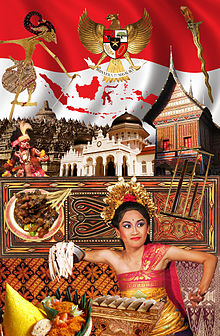
| Part of a series on the |
| Culture of Indonesia |
|---|
 |
| People |
| Languages |
| Mythology and folklore |
| Cuisine |
| Literature |
| Music and performing arts |
| Sport |
The culture of Indonesia (Indonesian: Budaya Indonesia) has been shaped by the interplay of indigenous customs and diverse foreign influences. With over 1,300 distinct ethnic groups, including significant Austronesian and Melanesian cultures, contributing to its rich traditions, languages, and customs, Indonesia is a melting pot of diversity. Positioned along ancient trade routes between the Far East, South Asia, and the Middle East, the country has absorbed cultural practices influenced by Hinduism, Buddhism, Confucianism, Islam, and Christianity. These influences have created a complex cultural tapestry that often differs from the original indigenous cultures.
Examples of the fusion of Islam with Hinduism include Javanese Abangan belief. Balinese dances have stories about ancient Buddhist and Hindu kingdoms, while Islamic art forms and architecture are present in Sumatra, especially in the Minangkabau and Aceh regions. Traditional art, music and sport are combined in a martial art form called Pencak Silat.
The Western world has influenced Indonesia in science, technology and modern entertainment such as television shows, film and music, as well as political system and issues. India has notably influenced Indonesian songs and movies. A popular type of song is the Indian-rhythmical dangdut, which is often mixed with Arabic, Javanese and Malay folk music.
Despite the influences of foreign culture, some remote Indonesian regions still preserve uniquely indigenous culture. Indigenous ethnic groups Batak, Nias, Mentawai, Asmat, Dani, Sumba, Dayak, Toraja and many others are still practising their ethnic rituals, customs and wearing traditional clothes.[1]
- ^ Taylor, Jean Gelman (2003). Indonesia peoples and Histories. Yale University Press. ISBN 0-300-10518-5.